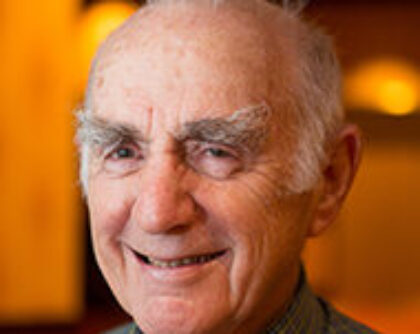Lee Grodzins
Research Interests
As a nuclear physicist, Dr. Grodzins has performed many profound and pioneering experiments. One of his early efforts was a measurement of the helicity of the neutrino. (Helicity characterizes the alignment of a particle’s intrinsic spin vector with that particle’s direction of motion). The elegance and subtleties of that experiment are now discussed in many textbooks on nuclear and elementary particle physics. The helicity measurement was a key to our understanding the so-called weak interaction, the force that governs nuclear beta decay. Other experiments probed the fundamental properties of nuclei such as the universal nature of certain electromagnetic transitions from first excited states in even-even nuclei, and the violation of parity. The trademark of Dr. Grodzins’ experiments has been the originality of the experimental technique and the significance of the questions addressed. For example, Dr. Grodzins performed the first computer axial tomographic experiment using synchrotron radiation in 1985.
Biographical Sketch
After graduating as an engineer from the University of New Hampshire in 1946, Lee was hired to work as an assistant in a nascent nuclear physics group at General Electric’s Research Laboratory in Schenectady. Those memorable two years led to graduate school in physics at Purdue University.
In 1955, Lee Grodzins took a postdoc position in Maurice Goldhaber’s nuclear physics group at Brookhaven National Laboratory. Lee so wanted to work with Maurice that he took a year-long instructorship at Purdue while waiting for an opening. Maurice gave him the timely problem of determining the properties of the beta-decay products of the radioactive isotope Eu-152. In 1957, near the end of those studies, Lee measured the femtosecond lifetime of one of the daughter states in Sm-152 that is fed by K-electron capture. The technique, still novel, used the neutrino’s momentum to produce resonant fluorescence in solid samarium. Its success was the basis for Goldhaber’s idea for determining the helicity of the neutrino’s spin in a table-top experiment that took but a few weeks. A postdoc experiment, motivated by curiosity and the promise of fun, was the foundation of an experiment of singular significance.
He joined the Physics department of MIT in 1959, retiring in 1998 to direct the R&D group at Niton Corporation, a company he founded in 1987 to develop and market instruments to measure toxic elements in the environment. Four of his instruments won R&D 100 awards, given yearly to the country’s 100 most innovative technical products.
Lee, who supervised 21 PhD recipients, has authored more than 150 technical papers and holds more than 50 U.S. patents. He was a Guggenheim Fellow in 1964–65 as well as in 1971–72, and a Senior von Humboldt Fellow in 1980–81. He is a Fellow of the American Physical Society and the American Academy of Arts and Sciences. He received an honorary Doctor of Science degree from Purdue University in 1998. MIT has named the Lee Grodzins Postdoctoral Award for him.
He is especially proud of being a founding member of the Union of Concerned Scientists and that in 2000 he founded Cornerstones of Science, a public library initiative to connect children and adults with science.
More info:
Courtesy of Cornerstones of Science | YouTube
Awards & Honors
- 2003 // R&D Magazine’s 2003 R&D 100 Award
- 2000 // Founder, Cornerstones of Science, a public library initiative to connect children and adults with science
- 1980 // Senior von Humboldt Fellow
- 1971 // John Simon Guggenheim Fellowship
- 1964 // John Simon Guggenheim Fellowship
